Thinkers, Beliefs and Buildings Class 12 History
Introduction
The ideas of philosophers have been preserved across a thousand years through various means, including oral and written texts, architecture, and sculpture. While Buddhism stands out as a major tradition, it did not develop in isolation; rather, it was part of a broader landscape where multiple traditions engaged in ongoing debates and dialogues. To explore this rich world of ideas and beliefs, historians rely on diverse sources such as Buddhist, Jaina, and Brahmanical texts, along with an extensive collection of material evidence like monuments and inscriptions. Among the most well-preserved monuments from this period is the stupa at Sanchi, showcasing the enduring legacy of these ancient philosophies.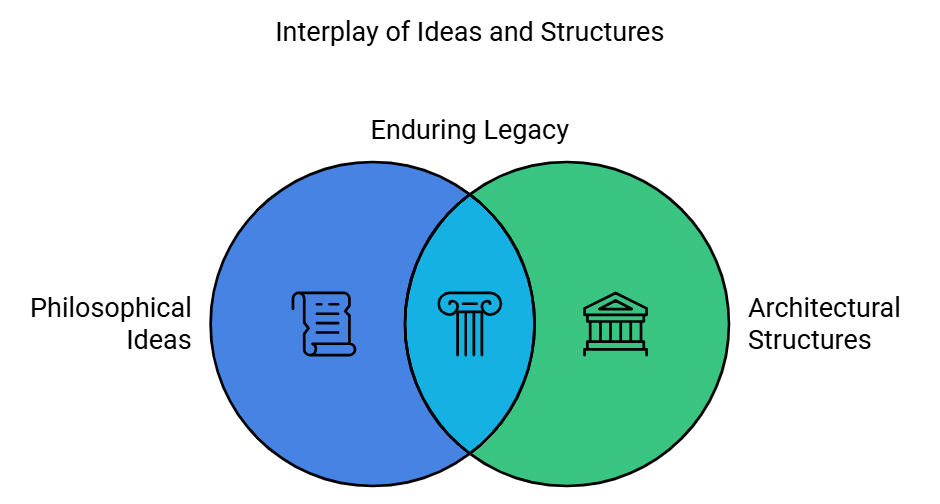
A Glimpse of Sanchi
- Nineteenth-century Europeans were very interested in the stupa at Sanchi. For instance, the French requested permission from Shahjehan Begum to take the eastern gateway to display it in a museum in France, and so did some Englishmen.
- The rulers of Bhopal, Shahjehan Begum and her successor Sultan Jehan Begum, provided money for the preservation of the ancient site.
- One of the most important Buddhist centres, the discovery of Sanchi has vastly transformed our understanding of early Buddhism. Today it stands testimony to the successful restoration and preservation of a key archaeological site by the Archaeological Survey of India (ASI).
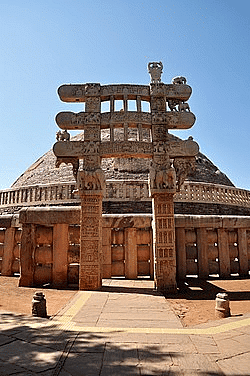
The Background: Sacrifices and Debates
- The mid-first millennium BCE is often regarded as a turning point in world history, as it saw the emergence of thinkers. They tried to understand the mysteries of existence and the relationship between human beings and the cosmic order.
- This was also the time when new kingdoms and cities were developing, and social and economic life was changing in a variety of ways in the Ganga valley.
The Sacrificial Tradition
- The early Vedic traditions, religious belief and practice were known from the Rigveda, compiled between c.1500 and 1000 BCE.
- Rigveda consisted of hymns, which were chanted when sacrifices were performed, where people prayed for cattle, sons, good health, long life, etc.
- At first, sacrifices were performed collectively. Later (c. 1000-500 BCE onwards), some were performed by the heads of households for the well-being of the domestic unit.
- More elaborate sacrifices, such as the rajasuya and ashvamedha, were performed by chiefs and kings who depended on Brahmana priests to conduct the ritual.
New Questions
- The ideas expressed in the Upanishads (around the sixth century BCE and later) reflect a deep curiosity about the meaning of life, the possibility of life after death, and the concept of rebirth.
- Thinkers were focused on exploring and articulating the nature of ultimate reality.
- Meanwhile, those outside the Vedic tradition started to question the significance of the sacrificial rituals and even challenged the existence of an ultimate reality.
Debates and Discussions
- Buddhist texts mention as many as 64 sects or schools of thought.
- Debates took place in the kutagarashala—literally, a hut with a pointed roof—or in groves where travelling mendicants halted.
- Mahavira and Buddha questioned the authority of the Vedas and emphasised individual agency, suggesting that men and women could strive to attain liberation from the trials and tribulations of worldly existence.
- This stood in sharp contrast to the Brahmanical view, which held that an individual’s existence was determined by their birth in a specific caste or gender.
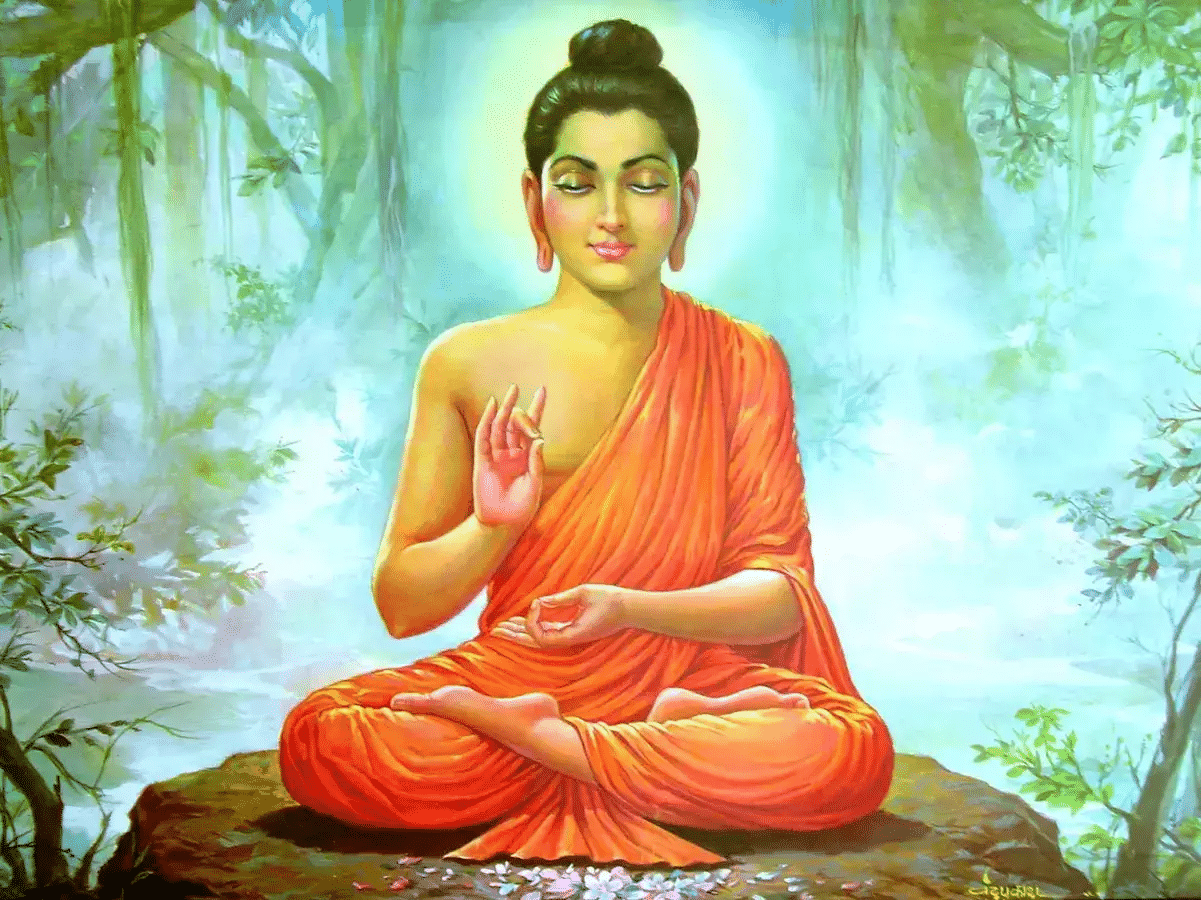
Beyond Worldly Pleasures: The Message of Mahavira
- The philosophy of the Jainas already existed before the birth of Mahavira in the sixth century BCE.
- Vardhamana, who came to be known as Mahavira, was preceded by 23 other teachers or tirthankaras, according to Jaina tradition.
- Tirthankaras are the teachers who guide men and women across the river of existence.
- The most important idea in Jainism is that the entire world is animated: even stones, rocks and water have life.
- The principle of ahimsa, emphasised within Jainism, has left its mark on Indian thinking as a whole.
- According to Jaina teachings, the cycle of birth and rebirth is shaped through karma.
- Asceticism and penance are required to free oneself from the cycle of karma. This can be achieved only by renouncing the world.
- Jaina monks and nuns took five vows: to abstain from killing, stealing and lying; to observe celibacy; and to abstain from possessing property.
- Gradually, Jainism spread to many parts of India. Jaina scholars produced a wealth of literature in a variety of languages – Prakrit, Sanskrit and Tamil.
The Spread of Jainism
- Jainism spread across various regions of India over time.
- Jain scholars produced extensive literature in Prakrit, Sanskrit, and Tamil, similar to Buddhist scholars.
- Manuscripts of Jain texts were carefully preserved in libraries connected to Jain temples for centuries.
- Early stone sculptures associated with Jain tirthankaras have been found at several archaeological sites throughout the Indian subcontinent.

The Buddha and The Quest for Enlightment
- The teachings and message of Buddha spread across the subcontinent and beyond – through Central Asia to China, Korea and Japan, and through Sri Lanka, across the seas to Myanmar, Thailand and Indonesia.
- According to Buddhist traditions, Siddhartha, as the Buddha was named at birth, was the son of a chief of the Sakya clan. He had a sheltered upbringing within the palace, but he was deeply anguished when he saw an old man, a sick man and a corpse.
- He also saw a homeless mendicant, who, it seemed to him, had come to terms with old age, disease and death, and found peace. Siddhartha decided that he too would adopt the same path. He then left the palace and set out in search of his own truth.
- He meditated for several days and finally attained enlightenment. After this, he came to be known as the Buddha or the Enlightened One.
- For the rest of his life, he taught dhamma or the path of righteous living.
The Teachings of the Buddha
- The Buddha’s teachings have been reconstructed from stories, found mainly in the Sutta Pitaka.
- Some stories describe his miraculous powers, others suggest that the Buddha tried to convince people through reason and persuasion rather than through displays of supernatural power..
- According to Buddhist philosophy, the world is transient (anicca) and constantly changing; it is also soulless (anatta) as there is nothing permanent or eternal in it. Within this transient world, sorrow (dukkha) is intrinsic to human existence.
- It is by following the path of moderation between severe penance and self-indulgence that human beings can rise above these worldly troubles.
- The Buddha regarded the social world as the creation of humans rather than of divine origin. So he advised kings and gahapatis to be humane and ethical.
- The Buddha emphasised individual agency and righteous action as the means to escape from the cycle of rebirth and attain self-realisation and nirvana, literally the extinguishing of the ego and desire, and thus end the cycle of suffering for those who renounced the world.
- Buddha’s last words to his followers were: “Be lamps unto yourselves as all of you must work out your own liberation.”
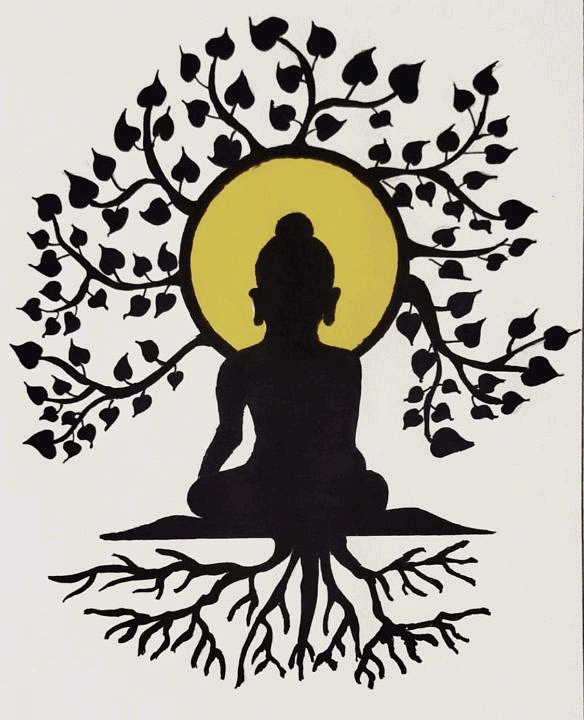
Followers of Buddha
- As the number of disciples of the Buddha increased and he founded a sangha, an organisation of monks who also became teachers of dhamma.
- These monks lived on alms, and so they were known as bhikkhus.
- Initially, only men were allowed into the sangha, but later women also came to be admitted. The Buddha’s foster mother, Mahapajapati Gotami, was the first woman to be ordained as a bhikkhuni.
- The Buddha’s followers came from many social groups. They included kings, wealthy men and gahapatis, and also humbler folk: workers, slaves and craftspeople.
- Once within the sangha, all were regarded as equal, having shed their earlier social identities on becoming bhikkhus and bhikkhunis.
- Buddhism grew rapidly as it appealed to many people dissatisfied with existing religious practices and confused by the rapid social changes taking place around them.
- The importance attached to conduct and values rather than claims of superiority based on birth drew men and women to Buddhist teachings.
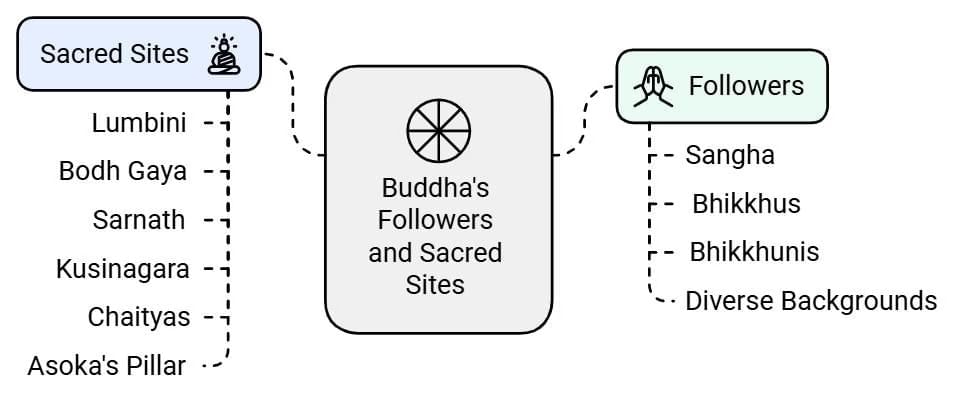
Stupas
- In Buddhist ideas and practices, people tended to regard certain places as sacred. These included sites with special trees or unique rocks, or sites of awe-inspiring natural beauty. These sites, with small shrines attached to them, were sometimes described as chaityas.
- Buddhist literature mentions several chaityas and describes significant places associated with the Buddha’s life: where he was born (Lumbini), where he attained enlightenment (Bodh Gaya), where he gave his first sermon (Sarnath), and where he attained nirvana (Kusinagara). Each of these locations became regarded as sacred.
- Around 200 years after the Buddha's time, Asoka erected a pillar at Lumbini to commemorate his visit to the site.
Why were Stupas Built?
- Besides, there were some places where relics of the Buddha, such as his bodily remains or objects used by him, were buried. These were mounds known as stupas.
- According to a Buddhist text known as the Ashokavadana, Asoka distributed portions of the Buddha’s relics to every important town and ordered the construction of stupas over them.
- By the second century BCE, a number of stupas, including those at Bharhut, Sanchi and Sarnath had been built.
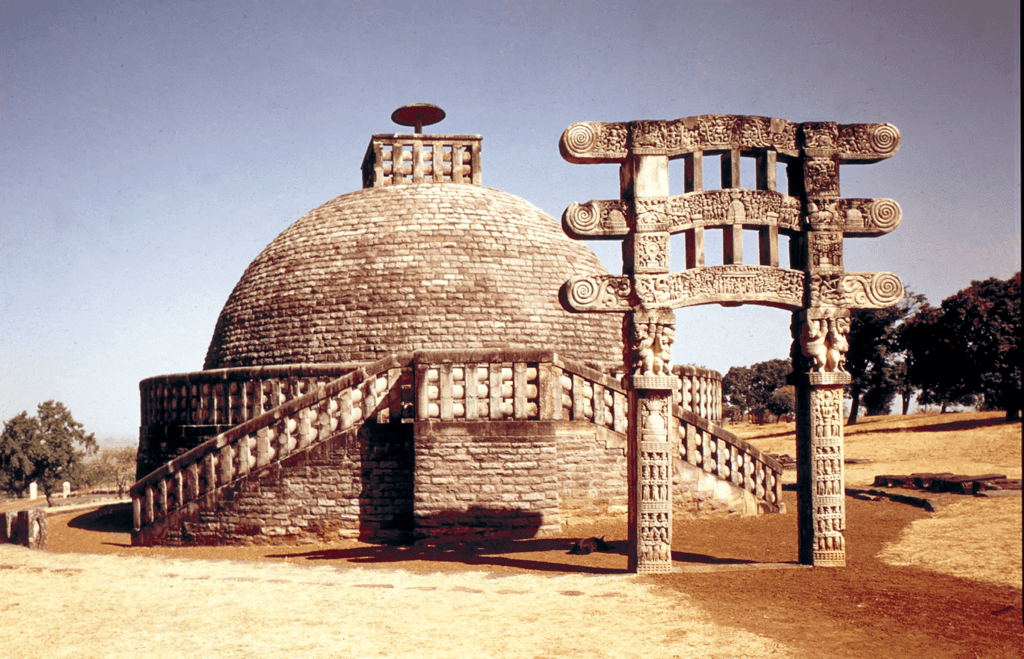
How were Stupas Built?
- Inscriptions found on the railings and pillars of stupas record donations made for building and decorating them.
- Bhikkhus and bhikkhunis also contributed towards building these monuments.
The Structure of the Stupa
The stupa (a Sanskrit word meaning "heap") originally began as a simple semi-circular mound of earth, known as anda. Over time, it evolved into a more complex structure that balanced round and square shapes.
- Arising from the harmika was a mast called the yashti, often surmounted by a chhatri or umbrella. Around the mound was a railing, separating the sacred space from the secular world.
- The early stupas at Sanchi and Bharhut were plain except for the stone railings. Later, the mound of the stupas came to be elaborately carved with niches and sculptures as at Amaravati, and Shahji-ki-Dheri in Peshawar (Pakistan).
- Each stupa has a history of its own. Sculptures of stupas were removed from stupas and transported all the way to Europe.
“Discovering” Stupas The Fate of Amaravati and Sanchi
Discovery of Amaravati: In 1796, a local raja stumbled upon the ruins of the stupa at Amaravati while planning to build a temple. This accidental discovery prompted further exploration.
British Officials' Role: Colin Mackenzie and later Walter Elliot, serving as commissioner of Guntur in Andhra Pradesh, played pivotal roles in collecting and distributing sculptures from Amaravati, known as the Elliot marbles.
H.H. Cole's Advocacy: Archaeologist H.H. Cole criticised the removal of original sculptures from Amaravati, advocating strongly for in situ preservation. His efforts were largely unsuccessful amidst widespread removal during the colonial era.
Comparison with Sanchi: Sanchi, discovered in 1818, managed to preserve its monuments better than Amaravati. Discussions arose about moving structures from Sanchi to Europe, but ultimately, conservation efforts helped maintain its integrity.
Decline of Amaravati: Due to the extensive removal of sculptures by British administrators, Amaravati's significance as a Buddhist stupa declined over time, contrasting sharply with Sanchi's conservation efforts and reflecting colonial attitudes towards archaeological preservation in India.
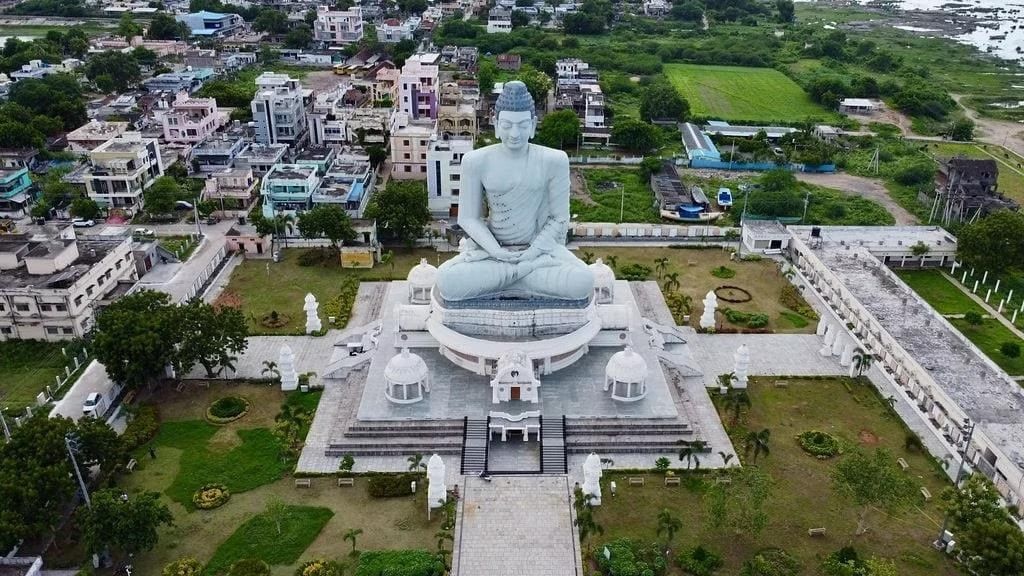
Sculpture
Stories in Stone- The Buddhist sculptures were beautiful and valuable.
- The sculpture in Sanchi seems to depict a scene from the story of Vessantara Jataka.
Symbols of Worship
- Many early sculptors did not show the Buddha in human form – instead, they showed his presence through symbols.
- The empty seat was meant to indicate the meditation of the Buddha, and the stupa was meant to represent the mahaparinirvana.
- Another frequently used symbol was the wheel. This stood for the first sermon of the Buddha, delivered at Sarnath.
Popular traditions
- A sculpture of a beautiful woman swinging from the edge of the gateway, holding onto a tree, was the representation of shalabhanjika.
- According to popular belief, shalabhanjika was a woman whose touch caused trees to flower and bear fruit. It is likely that this was regarded as an auspicious symbol and integrated into the decoration of the stupa.
- The shalabhanjika motif on most of the Buddhist sculptures suggests that many people who turned to Buddhism enriched it with their own pre-Buddhist and even non-Buddhist beliefs, practices and ideas.
- There are other motifs as well. Some of the finest depictions of animals are found there. These animals include elephants, horses, monkeys and cattle. While the Jatakas contain several animal stories that are depicted at Sanchi, it is likely that many of these animals were carved to create lively scenes to draw viewers.
- Animals were often used as symbols of human attributes. Elephants, for example, were depicted to signify strength and wisdom.
- Another motif is that of a woman surrounded by lotuses and elephants, which seem to be sprinkling water on her as if performing an abhisheka or consecration.
- The serpent motif is also found on several pillars. One of the earliest modern art historians, James Fergusson, considered Sanchi to be a centre of tree and serpent worship.
New Religious Traditions
The development of Mahayana Buddhism
- Early Buddhist teachings had given great importance to self-effort in achieving nirvana. Buddha was regarded as a human being who attained enlightenment and nirvana. Gradually, the idea of a saviour emerged.
- Simultaneously, the concept of the Bodhisatta also developed. Bodhisattas were perceived as deeply compassionate beings who accumulated merit through their efforts but used this not to attain nirvana and thereby abandon the world, but to help others. The worship of images of the Buddha and Bodhisattas became an important part of this tradition.
- This new way of thinking was called Mahayana – literally, the “great vehicle”. Those who adopted these beliefs described the older tradition as Hinayana or the “lesser vehicle”.
The Growth of Puranic Hinduism
- The notion of a saviour was not unique to Buddhism; it was also a part of Hinduism. Sects of Vaishnavism and Shaivism emerged in Hinduism, in which there was growing emphasis on the worship of a chosen deity.
- Vaishnavism – is a form of Hinduism within which Vishnu was worshipped as the principal deity, and Shaivism is a tradition within which Shiva was regarded as the chief god. In such worship, the bond between the devotee and the god was visualised as one of love and devotion, or bhakti.
- In Vaishnavism, cults developed around the various avatars or incarnations of the deity. Ten avatars were recognised within the tradition. Different avatars were popular in different parts of the country.
- Some of the avatars were represented in sculptures. For example, Shiva was symbolised by the linga.
- All such representations depicted a complex set of ideas about the deities and their attributes through symbols.
- Much of what is contained in the Puranas evolved through interaction amongst people who travelled from place to place, sharing ideas and beliefs.
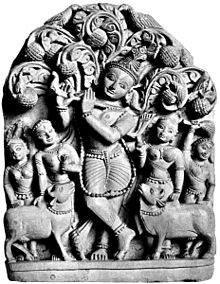
Building temples
- The early temple was a small square room, called the garbhagriha, with a single doorway for the worshipper to enter and offer worship to the image.
- Gradually, a tall structure, known as the shikhara, was built over the central shrine. Temple walls were often decorated with sculpture.
- Later temples became far more elaborate, with assembly halls, huge walls and gateways, and arrangements for supplying water.
- One of the unique features of early temples was that some of these were hollowed out of huge rocks, as artificial caves. The tradition of building artificial caves was an old one. Some of the earliest of these were constructed in the third century BCE on the orders of Asoka for renouncers who belonged to the Ajivika sect.
- This tradition evolved through various stages and culminated much later, in the eighth century, in the carving out of an entire temple, that of Kailashnatha (a name of Shiva).
Can we See Everything?
- The past holds rich visual traditions in brick and stone architecture, sculpture, and painting.
- Destruction over centuries has resulted in a significant loss of these cultural artefacts.
- Despite this, preserved remnants offer insight into the creative visions of ancient artists, sculptors, masons, and architects.
- Understanding the original intentions behind these artworks is challenging; it's not always clear what messages they were meant to convey.
- Interpreting what these images meant to people who venerated them around 2,000 years ago remains a complex and uncertain task.
Grappling with the unfamiliar
- Nineteenth-century European scholars struggled to interpret Indian sculptures depicting gods and goddesses, finding some grotesque due to multiple arms, heads, or human-animal combinations.
- They compared these sculptures to Greek models found in northwest cities like Taxila and Peshawar, considering Buddha and Bodhisattva images influenced by Greek art as prime examples of early Indian art.
- This approach reflects the use of familiar yardsticks to understand the unfamiliar in art.
If the text and image do not match
- Art historians face challenges in interpreting sculptures without clear textual references.
- A notable example is the sculpture at Mahabalipuram, where scholars debate whether it depicts the descent of the river Ganga or Arjuna's penance from the Mahabharata.
- This highlights the complexities in interpreting ancient Indian art, where texts provide context but not always definitive explanations, allowing for debate and multiple interpretations.
Timeline
Timeline 1: Major Religious Developments
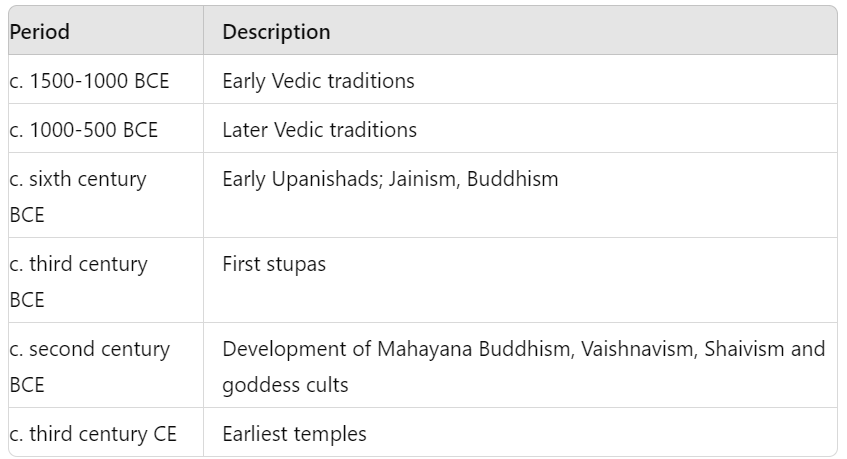
Timeline 2: Landmarks in the Discovery and Preservation of Early Monuments and Sculpture
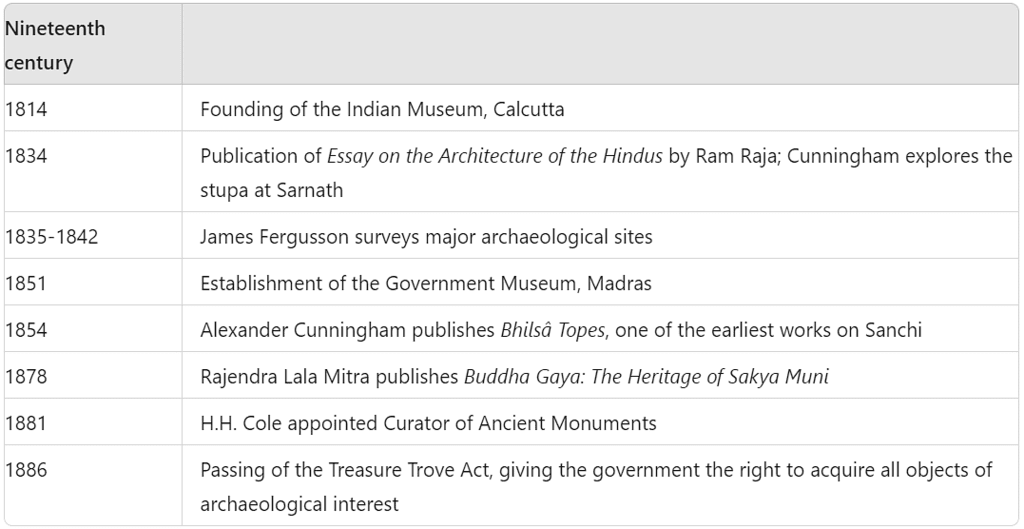
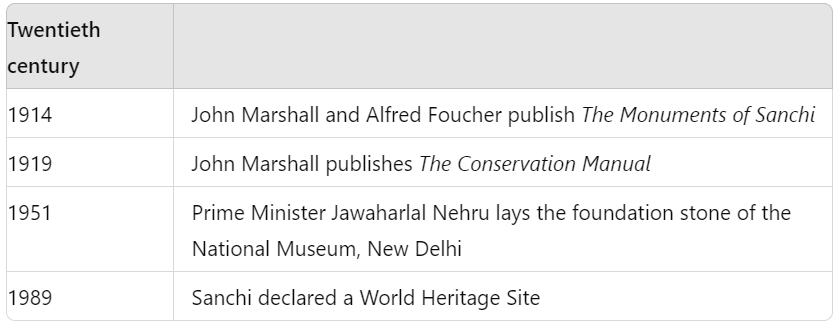
Summary
- Buildings of Sanchi Kannakkheda are the most wonderful ancient buildings in the state of Bhopal.
- Buddhist, Jaina and Brahmanical texts, monuments and inscriptions are some of the important historical sources of the age of C 600 BCE-600CE, which help in reconstructing Indian history.
- Many were provided by rulers of Bhopal, Shahjahan Begum and her successor Sultan Jahan Begum, to preserve the ancient sites.
- The Rigveda is a collection of hymns, praising many deities like Agni, Indra, Soma, etc.
- The basic philosophy of Jainism already existed in north India even before the birth of Vardhamana Mahavira.
- The Buddha was the most influential teacher of his time.
- Two traditions were included in modern Hinduism – Vaishnavism and Shaivism.
|
30 videos|274 docs|25 tests
|
FAQs on Thinkers, Beliefs and Buildings Class 12 History
| 1. What is the significance of the Sanchi Stupa in Buddhist architecture? |  |
| 2. Who was Mahavira, and what was his message regarding worldly pleasures? |  |
| 3. How did the teachings of the Buddha differ from those of Mahavira? |  |
| 4. What role do stupas play in Buddhist practice and beliefs? |  |
| 5. What is the historical significance of Amaravati and its connection to Sanchi? |  |






















